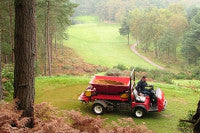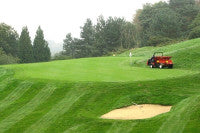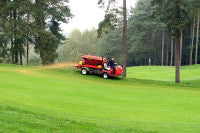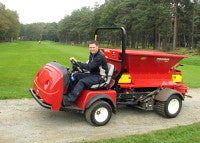Top dressings applied little and often counter increased levels of golf and threat of thatch
 A sharp increase in the amount of golf being played during the week at Old Thorns Golf and Country Estate, Liphook, Hampshire, has prompted a number of changes in the course maintenance regime followed by head greenkeeper, Derek Cunliffe.
A sharp increase in the amount of golf being played during the week at Old Thorns Golf and Country Estate, Liphook, Hampshire, has prompted a number of changes in the course maintenance regime followed by head greenkeeper, Derek Cunliffe.
Among the changes seen over the past year on the 18-hole parkland course is a doubling in the frequency of top dressing applications, with a ProPass 180 twin spinner broadcast-type machine from Turfmech taking over from a 1.5m wide drop-style spreader for the treatment primarily of tees, greens and their surrounds.
According to Derek, the new spreader was purchased for its ability to apply dressings evenly and lightly across bout widths of up to 9m (30ft), enabling the greens to be treated without holding up play or interfering with the run of the ball.
"It's simply a case of getting the job done as quickly and effectively as possible," pointed out Derek. "In fact, the high workrate of the ProPass 180 means that all 18 greens can receive a dressing of kiln-dried sand in well under two hours instead of the four hours taken by our previous
 machine, which was incapable also of applying such light applications. Further advantages are that the new spreader does not need reloading so often and we can now use two men to top dress and mat-in the material instead of the three required before."
machine, which was incapable also of applying such light applications. Further advantages are that the new spreader does not need reloading so often and we can now use two men to top dress and mat-in the material instead of the three required before."
The ProPass's ability to treat all 18 greens in less than half the time of its predecessor means that Derek has been able to increase the frequency of fine-turf top dressing during the growing season from once a month to every two weeks. The result has been improved surface drainage and thatch control with the greens becoming firmer and faster, assisted by the use of a "thatchaway" scarifying attachment on the greens mower, set to work at a depth of 5mm.
"Although the greens are of sand construction, the majority are shaded by trees which interfere also with air movement," commented Derek. "Add to
 these factors the wettish nature of the course and it is no surprise that thatch control is a major priority. As well as scarifying and top dressing, we also have a fortnightly solid tining programme from spring to autumn."
these factors the wettish nature of the course and it is no surprise that thatch control is a major priority. As well as scarifying and top dressing, we also have a fortnightly solid tining programme from spring to autumn."
Derek explained that when he became head greenkeeper in 1995, there was more time to deal with the thatch problem. Over the past three years, however, Old Thorns Golf and Country Estate has become an increasingly popular destination for societies and corporate golf breaks, with more than 32,000 rounds of golf being played during the past year.
Not only does this put more pressure on the greenkeeping team, particularly on Monday mornings, but it also puts more pressure on the turf, which can lead to compaction, impeded drainage . . . and thatch. "Previously, it was a constant battle to keep the greens in the best possible playing condition without temporarily disrupting the putting surfaces or interfering with the passage of play," said Derek. "The arrival of the ProPass 180 has changed the position completely for the benefit of all. We are able to complete the necessary work quickly and effectively. Members and visitors are able to play an uninterrupted round of golf. And the greens are firmer, healthier and better draining.

"The machine is doing a great job for us and has become an essential greenkeeping tool in a very short time. Although greens and tees remain the priority, I plan to use it on all close-mown areas of the course whenever possible during the coming year."
IMAGE CAPTIONS:
Old Thorns 1: Derek Cunliffe, head greenkeeper at Old Thorns Golf & Country Estate,
uses his ProPass 180 top dresser every two weeks during the growing season.
Old Thorns 2 and 3: Regular light sand dressing of Old Thorn's greens and surrounds helps keep the turf open and free-draining.
Old Thorns 4: Tees also receive little but often sand top dressings applied by the ProPass 180's twin rear spinning discs.
Article Tags:
Industry news